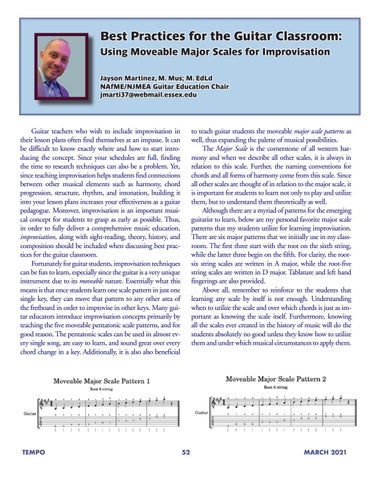Best Practices for the Guitar Classroom: Using Moveable Major Scales for Improvisation Jayson Martinez, M. Mus; M. EdLd NAfME/NJMEA Guitar Education Chair jmarti37@webmail.essex.edu
Guitar teachers who wish to include improvisation in their lesson plans often find themselves at an impasse. It can be difficult to know exactly where and how to start introducing the concept. Since your schedules are full, finding the time to research techniques can also be a problem. Yet, since teaching improvisation helps students find connections between other musical elements such as harmony, chord progression, structure, rhythm, and intonation, building it into your lesson plans increases your effectiveness as a guitar pedagogue. Moreover, improvisation is an important musical concept for students to grasp as early as possible. Thus, in order to fully deliver a comprehensive music education, improvisation, along with sight-reading, theory, history, and composition should be included when discussing best practices for the guitar classroom. Fortunately for guitar students, improvisation techniques can be fun to learn, especially since the guitar is a very unique instrument due to its moveable nature. Essentially what this means is that once students learn one scale pattern in just one single key, they can move that pattern to any other area of the fretboard in order to improvise in other keys. Many guitar educators introduce improvisation concepts primarily by teaching the five moveable pentatonic scale patterns, and for good reason. The pentatonic scales can be used in almost every single song, are easy to learn, and sound great over every chord change in a key. Additionally, it is also also beneficial
TEMPO
to teach guitar students the moveable major scale patterns as well, thus expanding the palette of musical possibilities. The Major Scale is the cornerstone of all western harmony and when we describe all other scales, it is always in relation to this scale. Further, the naming conventions for chords and all forms of harmony come from this scale. Since all other scales are thought of in relation to the major scale, it is important for students to learn not only to play and utilize them, but to understand them theoretically as well. Although there are a myriad of patterns for the emerging guitarist to learn, below are my personal favorite major scale patterns that my students utilize for learning improvisation. There are six major patterns that we initially use in my classroom. The first three start with the root on the sixth string, while the latter three begin on the fifth. For clarity, the rootsix string scales are written in A major, while the root-five string scales are written in D major. Tablature and left hand fingerings are also provided. Above all, remember to reinforce to the students that learning any scale by itself is not enough. Understanding when to utilize the scale and over which chords is just as important as knowing the scale itself. Furthermore, knowing all the scales ever created in the history of music will do the students absolutely no good unless they know how to utilize them and under which musical circumstances to apply them.
52
MARCH 2021














